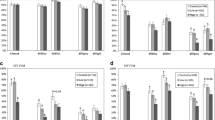Background
One-cell mouse embryos were used to determine the effects of drop size and number of embryos per drop for optimum development in vitro.
Methods
Embryos were collected from immature C57BL6 female mice superovulated with pregnant mare serum gonadotropin and human chorionic gonadotropin and mated by CD1 males. Groups of 1, 5, 10, or 20 embryos were cultured in 5-, 10-, 20-, or 40-µl drops of CZB under silicon oil at 37.5°C in a humidified atmosphere of 5% CO 2 and 95% air.
Results
Development score for embryos cultured in 10 µl was higher than that of embryos cultured in 20 or 40 µl. Embryos cultured in groups of 5, 10, or 20 had higher development scores than embryos cultured singly. The highest development score was obtained by the combination of 5 embryos per 10-µl drop. The percentage of live embryos in 20 or 40 µl was lower than that of embryos cultured in 10 µl. Additionally, the percentage of live embryos cultured singly was lower than that of embryos cultured in groups.
Conclusions
Our results suggest that a stimulatory interaction occurs among embryos possibly exerted through the secretion of growth factors. This effect can be diluted if the embryos are cultured in large drops or singly.
Similar content being viewed by others
References
Brinster RL: A method for in vitro cultivation of mouse ova from two-cell to blastocyst. Exp Cell Res 1963;32:205–208
Wiley LM, Yamami Sand Munden VD: Effect of potassium concentration, type of protein supplement, and embryo density on mouse preimplantation embryo development in vitro. Fertil Steril 1986;45:111–119
Paria BC, Dey SK: Preimplantation embryo development in vitro: Cooperative interaction among embryos and role of growth factors. Proc Natl Acad Sci USA 1990;87:4756–4760
Chatot CL, Ziomek CA, Bavister BD, Lewis JL, Torres I: An improved culture medium supports development of random-bred 1-cell mouse embryos in vitro. J Reprod Fert 1989;86:679–688
SAS: SAS User's Guide: Statistics. Cary, NC, SAS Institute, 1985
Quinn P, Hirayamada T, Marrs RP: Cooperative interaction among mouse zygotes cultured in protein-free medium: Blastocyst development and hatching. Serono Symposium on Preimplantation Embryo Development, 1991, p 68 (abstr)
Rapolee DA, Brenner CA, Schultz R, Mark D, Verb Z: Developmental expression of PDGF, TGFα, and TGFβ genes in preimplantation mouse embryos. Science 1988;241:1823–1825
Lane M, Gardner DK: Effect of incubation volume and embryo density on the development and viability of mouse embryos in vitro. Serono Symposium on Preimplantation Embryo Development, 1991, p 33 (abstr)
Dey SK, Paria BC: Chemical signals in embryo-maternal dialog: Role of growth factors. Serono Symposium on Preimplantation Embryo Development, 1991, p 21 (abstr)
Author information
Authors and Affiliations
Rights and permissions
About this article
Cite this article
Canseco, R.S., Sparks, A.E.T., Pearson, R.E. et al. Embryo density and medium volume effects on early murine embryo development. J Assist Reprod Genet 9, 454–457 (1992). https://doi.org/10.1007/BF01204051
Received:
Accepted:
Issue Date:
DOI: https://doi.org/10.1007/BF01204051




